阅读以下说明和C++程序,将应填入(n)处的字句写在对应栏内。【说明】以下程序的功能是设计一个栈类stack<T>,并建立一个整数栈。【程序】include < iostream. h >include < stdlib. h >const int Max =20; //栈大小template < class T >class stack{ //栈元素数组T s[Max]; //栈顶下标int top;public:stack( ){top =-1; //栈顶初始化为-1}void push( const
题目
阅读以下说明和C++程序,将应填入(n)处的字句写在对应栏内。
【说明】
以下程序的功能是设计一个栈类stack<T>,并建立一个整数栈。
【程序】
include < iostream. h >
include < stdlib. h >
const int Max =20; //栈大小
template < class T >
class stack{ //栈元素数组
T s[Max]; //栈顶下标
int top;
public:
stack( )
{
top =-1; //栈顶初始化为-1
}
void push( const T &item); //item入栈
T pop( ); //出栈
int stackempty( ) const; //判断栈是否为
};
template < class T >
void stack <T >::push(const T &item)
{
if(top==(1))
{
cout <<"栈满溢出" <<endl;
exit(1);
}
top ++
s[top] = item;
}
template < class T >
T stack<T> ::pop()
{
T temp;
if(top==(2))
{
cout <<"栈为空,不能出栈操作" < < endl;
exit(1);
}
temp =s[top];
top --;
return temp;
}
template < class T >
int stack < T >:: stackempty( ) const
{ return top == -1;
{
void main( )
{
stack <int> st;
int a[] ={1,2,3,4,5};
cout <<"整数栈" <<endl;
cout <<"入栈序列:" <<endl;
for(int i=0;i<4;i ++)
{
cout <<a[i] <<" ";
(3);
}
cout << endl <<"出栈序列";
while((4))
tout<<(5)<<" ";
cout< < endl;
}
相似考题
更多“阅读以下说明和C++程序,将应填入(n)处的字句写在对应栏内。【说明】 以下程序的功能是设计一个栈类s ”相关问题
-
第1题:
阅读以下说明和c++码,将应填入(n)处的字名写在的对应栏内。
[说明] 以下函数完成求表达式

的值,请填空使之完成此功能。
float sum ( float x )
{ float s=0.0;
int sign = 1;
(1);
for(inti=1;(2); i+ +)
{
t=t*x;
s=s+(3);
sign = - sign;
(4);
}
正确答案:float t =1.0; i< =100 - sign * i/( t + sign* i) return s
float t =1.0; i< =100 - sign * i/( t + sign* i) return s -
第2题:
试题三(共 15 分)
阅读以下说明和 C 程序,将应填入 (n) 处的字句写在答题纸的对应栏内。
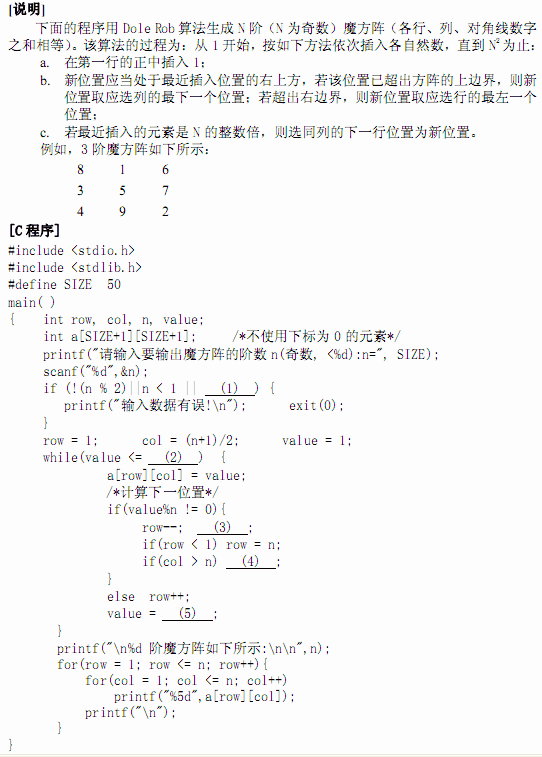 正确答案:
正确答案: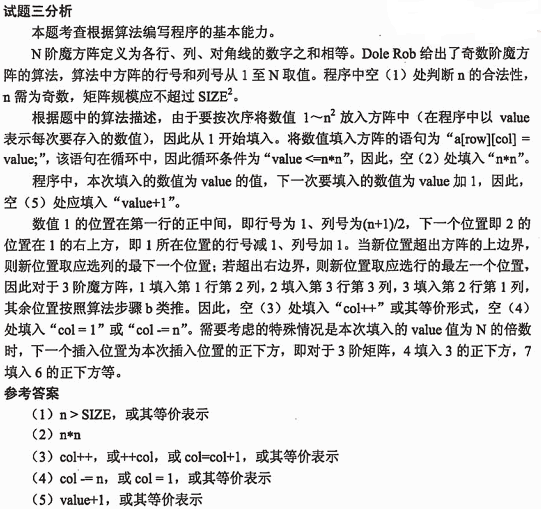
-
第3题:
阅读下列说明和?C++代码,将应填入(n)处的字句写在答题纸的对应栏内。
【说明】
阅读下列说明和?Java代码,将应填入?(n)?处的字句写在答题纸的对应栏内。
【说明】
某快餐厅主要制作并出售儿童套餐,一般包括主餐(各类比萨)、饮料和玩具,其餐品种
类可能不同,但其制作过程相同。前台服务员?(Waiter)?调度厨师制作套餐。现采用生成器?(Builder)?模式实现制作过程,得到如图?6-1?所示的类图。
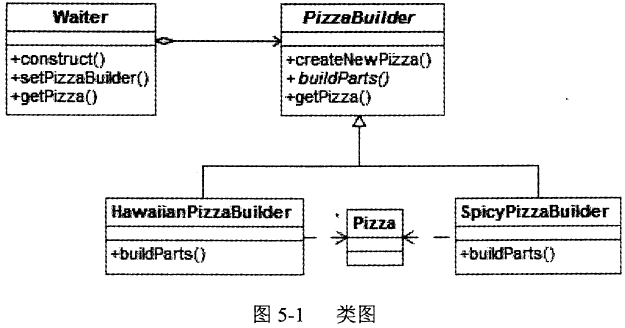
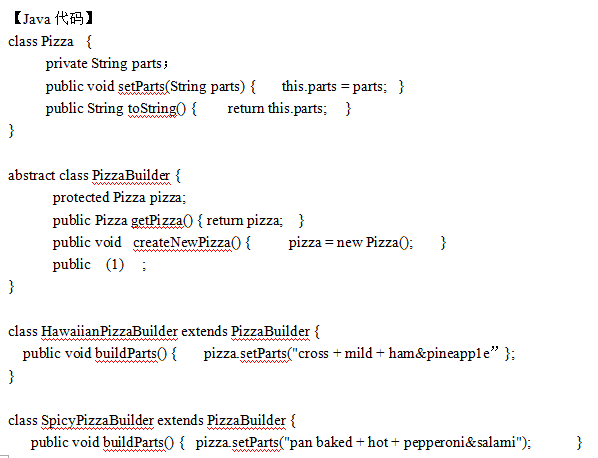
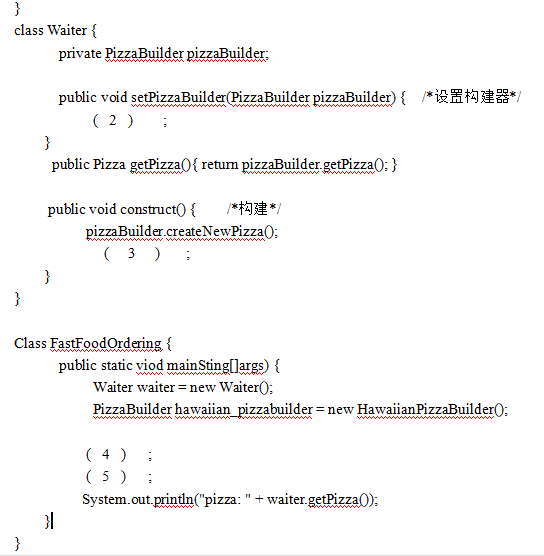
 答案:解析:
答案:解析: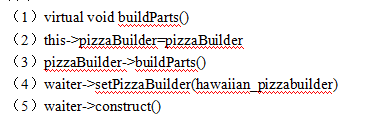
-
第4题:
阅读下列程序说明和C++程序,把应填入其中(n)处的字句,写在对应栏内。
【说明】
阅读下面几段C++程序回答相应问题。
比较下面两段程序的优缺点。
①for (i=0; i<N; i++ )
{
if (condition)
//DoSomething
…
else
//DoOtherthing
…
}
②if (condition) {
for (i =0; i<N; i++ )
//DoSomething
}else {
for (i=0; i <N; i++ )
//DoOtherthing
…
}
正确答案:程序1优点:程序简洁;缺点:多执行了N-1次逻辑判断并且程序无法循环“流水”作业使得编译器无法对循环进行优化处理降低了效率。 程序2优点:循环的效率高;缺点:程序不简洁。
程序1优点:程序简洁;缺点:多执行了N-1次逻辑判断,并且程序无法循环“流水”作业,使得编译器无法对循环进行优化处理,降低了效率。 程序2优点:循环的效率高;缺点:程序不简洁。 -
第5题:
阅读下列说明和C++-代码,将应填入(n)处的字句写在答题纸的对应栏内。 【说明】 某发票(lnvoice)由抬头(Head)部分、正文部分和脚注(Foot)部分构成。现采用装饰(Decorator)模式实现打印发票的功能,得到如图5-1所示的类图。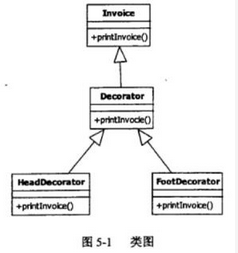
【C++代码】 #includeusing namespace std; class invoice{ public: (1){ cout<<"This is the content of the invoice!"< 答案:解析:(1) virtual void printInvoice() (2) ticket->printInvoice() (3) Decorator::printInvoice() (4) Decorator::printInvoice() (5) &a
【解析】
试题分析
1.Invoice类下,义虛函数,按类图,函数名是printInvoice
2.前面定义对象名是ticket,那么在ticket不为空的时候调用函数printInvoice
3.这部分填写发票的抬头,看类图应该实现函数printInvoice ,Decorator装饰模式使用该方法
4.这部分是发票的脚注,看类图应该实现函数printlnvoice,Decorator装饰模式使用该方法
5.FootDecorator a(NULL) ;脚步的装饰参数是a,调用a参数,
